CloudBees Series A Funding

The Boston Globe broke the news this morning . CloudBees has taken a round of financing led by Matrix Partners. While not quite the reunion of the Beatles, Sacha has brought together some of the characters from the JBoss experience – David Skok, Marc Fleury. I kind of feel like Ringo – not quite as cool as John, Paul and George… We had a number of discussions with different VC’s, and in the end decided that David had done so much to help JBoss be successful that it was the best way to go. He has a somewhat unique depth of experience from being an entrepreneur himself 5 times over. And of course his success as a VC is widely well regarded. One of the interesting things about this investment team that matches up well with the technology team we have in place is being prepared to run a marathon. We are building for the long run. Here's the official press release .



